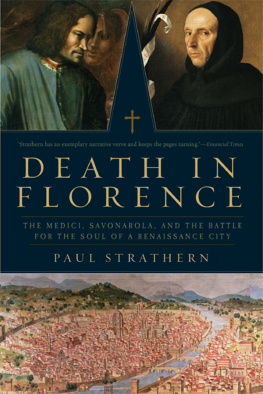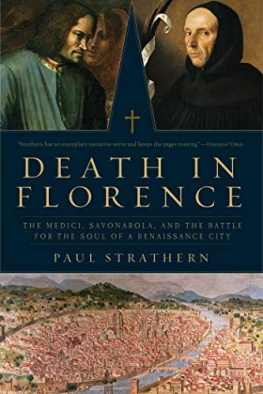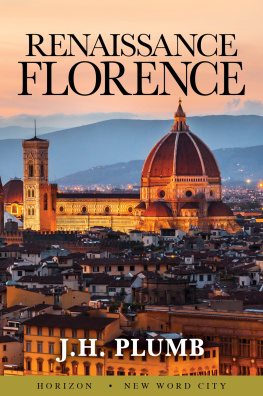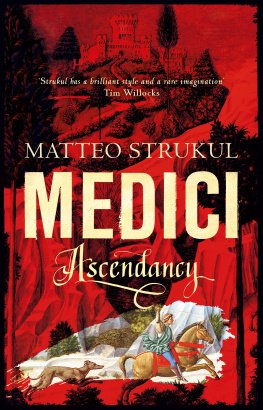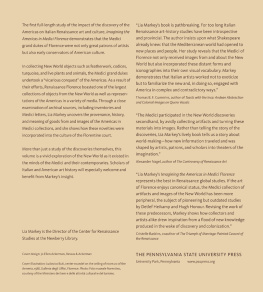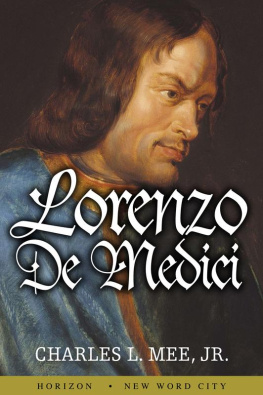
DEATH IN FLORENCE
THE MEDICI, SAVONAROLA, AND THE BATTLE FOR THE SOUL OF A RENAISSANCE CITY

PAUL STRATHERN

PEGASUS BOOKS
NEW YORK LONDON
To my brother Mark
Contemporary portrait of Savonarola by his friend Fra Bartolomeo. Florence, Museo di San Marco. 2010. Photo Scala, Florence courtesy of the Ministero Beni e Att. Culturali.
2a. Portrait bust of Lorenzo de Medici, probably after a model by Andrea delVerrocchio and Orsini Benintendi. Palazzo Medici-Riccardi, Florence, Italy /The Bridgeman Art Library.
2b. Portrait of Piero de Medici by Angelo Bronzino (150372). Private Collection/The Bridgeman Art Gallery.
The Carta della Catena showing a panorama of Florence, 1490. Museo de Firenze Comera, Florance, Italy/Alinari/The Bridgeman Art Library.
4a. Portrait of Alexander VI. Vatican, Pinacoteca. 2010. Photo Scala, Florence.
4b. Portrait bust of Charles VIII, King of France (c.14831498). Museo Nazionale del Bargello, Florence. Alinari Archives, Florence.
5a. Portrait of Pico della Mirandola by Cristofano dell Altissiomo (c.15251605). Florence, Galleria degli Uffizi (Gioviani Collection). 2010. Photo Scala, Florence courtesy of the Ministero Beni e Att. Culturali.
5b. Portrait of Angelo Poliziano (14851490). Detail of a fresco of the sacrifice of the prophet Zechariah, by Domenico Ghirlandaio in the Main Chapel of the Church of Santa Maria Novella in Florence. Alinari Archives, Florence.
5c. Portrait of Marsilio Ficino. 2010. White Images/Scala, Florence.
6a. Savonarola preaching. 2010. Photo Ann Ronan/Heritage Images/Scala, Florence.
6b. Self-portrait of Sandro Botticelli. Detail from Adoration of the Magi. Florence, Galleria degli Uffizi. 2010. Photo Scala, Florence courtesy of the Ministero Beni e Att. Culturali.
The Birth of Venus by Sandro Botticelli (14451510). Florence, Galleria degli Uffizi. 2010. Photo Scala, Florence courtesy of the Ministero Beni e Att. Culturali.
Botticellis illustration to Dantes Divine Comedy c.1480. Berlin, Kupferstichkabinett, Staatliche Museen zu Berlin. 2010. Photo Scala, Florence/BPK, Bildagentur fr Kunst, Kultur und Geschichte, Berlin.


Alexander VI notoriously corrupt Borgia Pope who became Savonarolas sworn enemy
Alfonso, Duke of Calabria son and heir of King Ferrante I of Naples. Would later become Alfonso II of Naples
Anne of France acted as Regent during the youth of Charles VIII
Arrabbiati the most powerful anti-Savonarola faction Bigi faction supporting return of Piero de Medici
Sandro Botticelli renowned painter and friend of Lorenzo the Magnificent
Fra Pacifico Burlamacchi wrote early biography of Savonarola, much of it heard from Savonarola himself
Piero di Gino Capponi leading Florentine citizen who famously defied Charles VIII
Cardinal Caraffi of Naples friend of Alexander VI who nonetheless supported Savonarola
Ser Ceccone (real name Francesco de Ser Barone) Savonarolas chief civil interrogator
Charles VIII the young King of France who invaded Italy
Compagnacci fanatically anti-Savonarola group led by Doffo Spini
Commines (Commynes) leading adviser of Charles VIII who kept a diary
Cardinal della Rovere sworn enemy of Alexander VI, who encouraged Charles VIII to set up a council to depose him
Bartolomeo Cerretani contemporary Florentine chronicler
Domenico da Pescia the Dominican monk who was Savonarolas closest and most loyal supporter, who followed his master to the end
Lucrezia Donati the most beautiful woman in Florence, to whom the young Lorenzo the Magnificent addressed love poems
Ferrante I King of Naples who received Lorenzo the Magnificent
Marsilio Ficino celebrated Platonist and close friend of Medici family
Francesco da Puglia a Franciscan monk from Santa Croce and a bitter enemy of Savonarola who issued the challenge for the ordeal by fire
Battista Guarino the celebrated humanist scholar whose lectures Savonarola attended at the University of Ferrara
Francesco Guicciardini contemporary historian of Florence and Italy
Fra Leonardo da Fivizzano Augustinian monk at Santo Spirito who preached in Florence against Savonarola when he was at the height of his power
Giovanni della Vecchia the Captain of the Square, responsible for keeping the peace in the Piazza della Signoria, and later at San Marco
Giovanni Manetti the Arrabbiati responsible for stirring up the crowd at the ordeal by fire, who later demanded permission to inspect Savonarola
Niccol Machiavelli contemporary historian of Florence and Italy
Fra Malatesta (Sacramoro) the Arrabbiati spy in San Marco
Domenico Mazzinghi pro-Savonarolan gonfaloniere who later argued in favour of the ordeal by fire
Fra Mariano da Genazzano the Augustinian who was Florences favourite preacher before his contest with Savonarola
Cosimo de Medici the man who built up the Medici bank, grandfather of Lorenzo the Magnificent
Giovanni de Medici second son of Lorenzo the Magnificent, who became a young cardinal
Giovanni di Pierfrancesco de Medici taken into the Palazzo Medici by his uncle Lorenzo the Magnificent as a youth when his father Pierfrancesco died.
Giuliano de Medici Lorenzo the Magnificents younger brother, who was murdered
Lorenzo de Medici (Lorenzo the Magnificent) effective ruler of Florence until 1492
Lorenzo di Pierfrancesco de Medici son of Pierfrancesco de Medici. Taken into the Palazzo Medici as a youth when his father died
Lucrezia (ne Tornabuoni) de Medici Lorenzo the Magnificents influential mother
Fra Ludovico da Ferrara despatched to Florence by Alexander VI to investigate Savonarola
Fra Silvestro Maruffi monk at San Marco prone to visions who would follow Savonarola to the end
Pierfrancesco de Medici cousin of Piero de Medici and grandson of Giovanni di Bicci, the founder of the Medici bank
Piero de Medici first son of Lorenzo the Magnificent who took over his rule of Florence in 1492
Dietisalvi Neroni long-term business associate of Cosimo de Medici, who grew jealous of Piero de Medici
Clarice (ne Orsini) de Medici Lorenzo the Magnificents Roman bride
Pico della Mirandola charismatic Renaissance philosopher, befriended by Lorenzo the Magnificent, his biography was written by his nephew, Francesco Pico della Mirandola
Piero Parenti Florentine diarist during this period
Piagnoni Savonarolas supporters, mainly drawn from amongst the poor, but extending into all sections of Florentine society
Angelo Poliziano renowned poet and member of Lorenzo the Magnificents circle
Bishop Remolino finally despatched by Alexander VI to conduct Savonarolas examination
Bernardo Rucellai leading Florentine citizen sent by Lorenzo the Magnificent on delegation to persuade Savonarola to tone down his sermons; later turned against Peiro de Medici (the Unfortunate)
Next page
